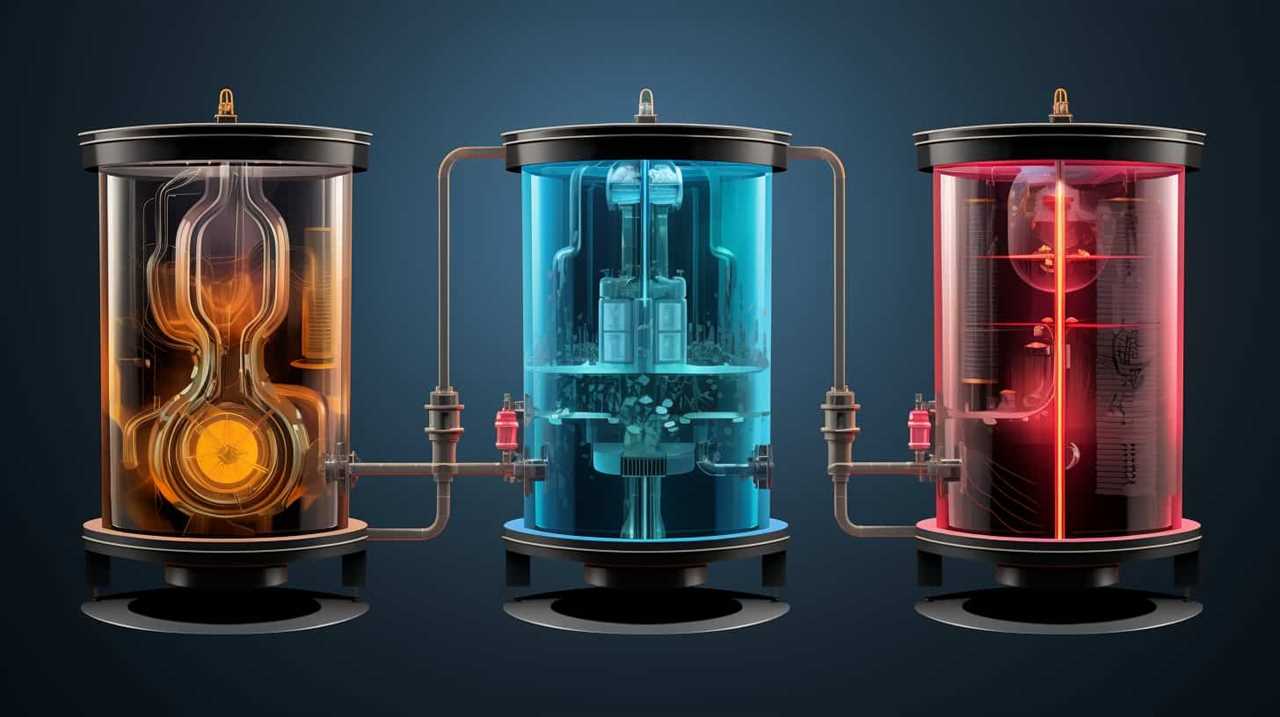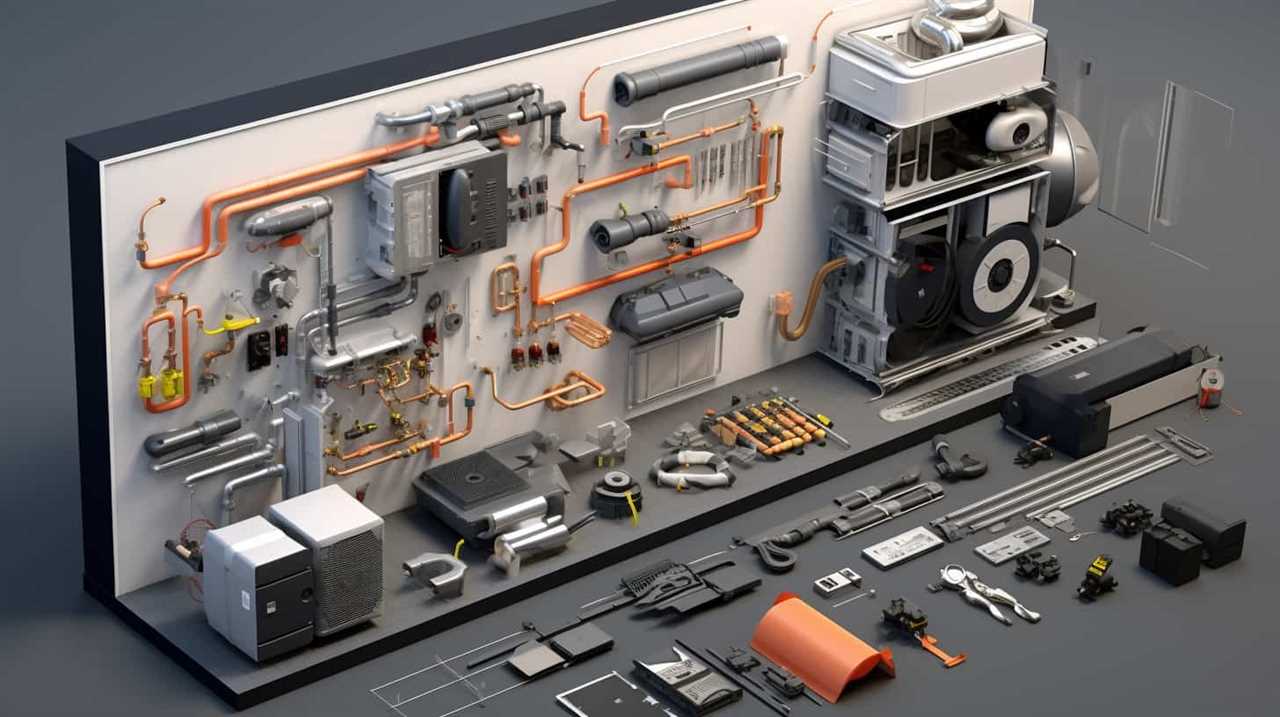As we explore the intricate world of sustainable building, we are seeking creative solutions to address our energy challenges. Heat pumps have emerged as a revolutionary technology that can help us achieve a more environmentally friendly future.
With their ability to harness renewable energy and maximize energy efficiency, heat pumps are revolutionizing the way we build. In this article, we will explore the role of heat pumps in solving energy issues, examining their benefits and showcasing successful case studies.
Join us as we delve into the world of sustainable construction and the power of heat pumps.
Key Takeaways
- Heat pumps contribute to a decrease in greenhouse gas emissions and promote energy efficiency.
- They provide both heating and cooling, reducing the need for fossil fuel-based systems.
- Heat pumps harness renewable energy sources and allow for the integration of other renewable heating sources.
- They offer significant energy efficiency benefits, reducing energy consumption and operating costs while improving indoor air quality.
The Role of Heat Pumps in Sustainable Construction
We can explore the benefits of heat pumps in sustainable construction by understanding their role in reducing energy consumption and promoting environmental conservation.

Heat pump technology is a key component in achieving energy efficiency and reducing the carbon footprint of buildings. Heat pumps work by transferring heat from one location to another, utilizing the natural heat present in the air, ground, or water. By extracting and utilizing this heat, heat pumps can provide both heating and cooling to a building, significantly reducing the need for traditional heating and cooling systems that rely on fossil fuels.
This reduction in energy consumption leads to a decrease in greenhouse gas emissions, making heat pumps a crucial element in sustainable construction. When implemented effectively, heat pump technology can contribute to a more environmentally friendly and energy-efficient built environment.
Energy Efficiency Benefits of Heat Pumps in Green Building
Heat pumps offer significant energy efficiency benefits in green building projects by reducing energy consumption and promoting sustainable practices. One of the key advantages of heat pumps is their ability to provide both heating and cooling, making them versatile and efficient systems.
Heat pumps work by transferring heat from one location to another, rather than generating heat through combustion processes. This results in lower energy consumption compared to traditional heating and cooling systems. Moreover, heat pumps can achieve high levels of energy savings by taking advantage of renewable energy sources such as the ground, air, or water.

Harnessing Renewable Energy With Heat Pump Technology
By utilizing heat pump technology, we can effectively harness renewable energy sources to power sustainable construction projects.
Heat pumps are devices that transfer heat from one location to another, using a small amount of electricity. They work by extracting heat from the air, ground, or water, and then transferring it to a building for heating or cooling purposes.
This process is highly efficient and can significantly reduce emissions compared to traditional heating systems.
Heat pump technology also allows for the integration of renewable heating sources, such as solar or geothermal energy, further reducing reliance on fossil fuels.

Overcoming Energy Challenges: Heat Pumps as a Solution
One of the main challenges in the field of sustainable construction is the reliance on non-renewable energy sources. But with heat pumps, we can overcome these challenges and provide a solution.
Heat pumps offer a range of benefits that make them an ideal choice for reducing carbon emissions and achieving cost-effective heating. Consider the following:
-
Energy Efficiency: Heat pumps are highly efficient, extracting heat from the environment and transferring it into buildings. This reduces the need for traditional heating methods that rely on fossil fuels, resulting in significant carbon emission reductions.
-
Renewable Energy Integration: Heat pumps can be powered by renewable energy sources such as solar or wind, further enhancing their sustainability and reducing reliance on non-renewable energy.

-
Versatility: Heat pumps can provide both heating and cooling, offering year-round comfort while minimizing energy consumption.
-
Cost Savings: By utilizing the natural heat from the environment, heat pumps can provide cost-effective heating solutions, reducing energy bills in the long run.
-
Long Lifespan: Heat pumps are durable and designed to last for many years, providing a reliable and sustainable heating solution.
With their numerous advantages, heat pumps offer an effective solution to overcome energy challenges in sustainable construction. By embracing this technology, we can make significant strides towards a greener and more sustainable future.

Case Studies: Successful Implementation of Heat Pumps in Eco-Friendly Construction
We have witnessed successful implementation of heat pumps in eco-friendly construction through various case studies. These case studies highlight the effectiveness of heat pumps in reducing energy consumption and greenhouse gas emissions. One such case study is the Bullitt Center in Seattle, which achieved net-zero energy status by utilizing ground source heat pumps for heating and cooling. Another example is the Crystal Bridges Museum of American Art in Arkansas, which integrated geothermal heat pumps into its HVAC system, resulting in significant energy savings. Additionally, the NYSERDA Building in New York City successfully implemented air-source heat pumps to meet its heating and cooling needs while reducing its carbon footprint. These successful case studies demonstrate the potential of heat pumps in eco-friendly construction and emphasize the importance of their implementation in sustainable building practices.
| Case Study | Location | Heat Pump Type |
|---|---|---|
| Bullitt Center | Seattle | Ground Source |
| Crystal Bridges Museum of American Art | Arkansas | Geothermal |
| NYSERDA Building | New York City | Air-Source |
Frequently Asked Questions
How Do Heat Pumps Work and How Are They Used in Sustainable Construction?
Heat pumps work by transferring heat from a lower temperature source to a higher temperature space using refrigerant. They are used in sustainable construction to provide energy efficient heating and cooling, reducing carbon emissions and energy consumption.
What Are the Main Advantages of Using Heat Pumps in Green Building Projects?
The advantages of using heat pumps in green building projects are numerous. They offer high efficiency and can reduce energy consumption, resulting in lower operating costs and a smaller carbon footprint.
Can Heat Pumps Be Used With Different Types of Renewable Energy Sources?
Heat pumps can be used with different types of renewable energy sources such as wind power and solar energy. This allows for a more sustainable and efficient approach to heating and cooling in green building projects.

What Are the Main Challenges Faced When Implementing Heat Pump Technology in Eco-Friendly Construction?
Implementing heat pump technology in eco-friendly construction presents several challenges. These include ensuring proper integration with existing systems, optimizing energy efficiency, and addressing potential limitations in space and infrastructure.
Are There Any Specific Case Studies or Examples of Successful Heat Pump Implementation in Sustainable Construction Projects?
Case studies provide valuable insights into the benefits, applications, and challenges of heat pump implementation in sustainable construction projects. These examples showcase the successful utilization of renewable energy sources, highlighting the positive impact on sustainability.
Conclusion
In conclusion, heat pumps prove to be a vital solution for sustainable construction, addressing energy issues and promoting green building practices.
By efficiently utilizing renewable energy sources, such as geothermal or air, heat pumps significantly reduce carbon emissions and energy consumption.

Through successful case studies, it’s evident that the implementation of heat pump technology in eco-friendly construction projects is both feasible and effective.
So let’s embrace this game-changing technology and pave the way for a greener future.









